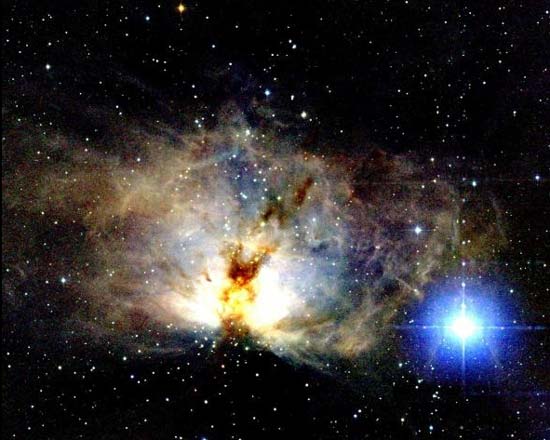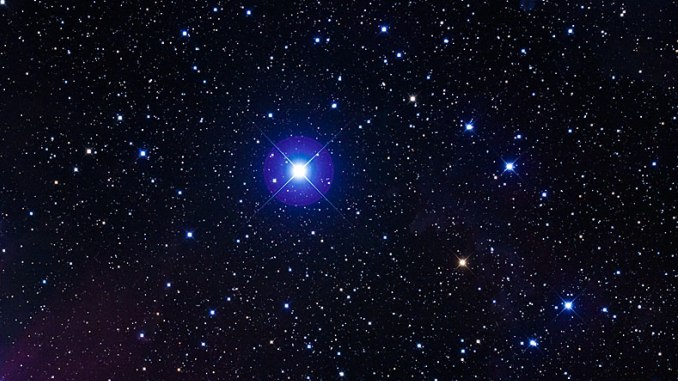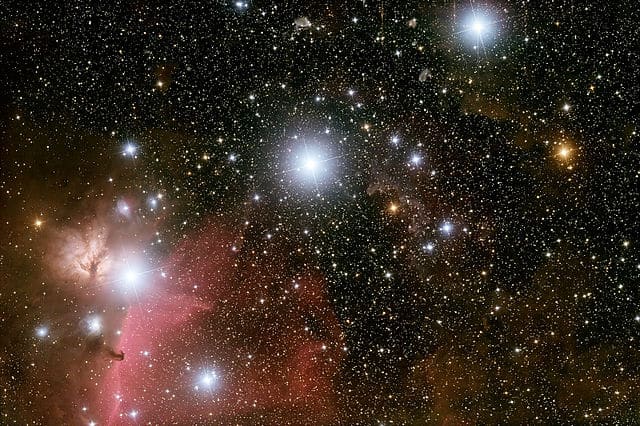Orion’s Belt or the Belt of Orion is an asterism in the constellation Orion. The asterism consists of three bright stars Alnitak, Alnilam, and Mintaka
Key Facts & Summary
- One of the easiest ways of finding the constellation of Orion is by locating Orion’s Belt.
- The three stars which form the asterism are more or less evenly spaced in a straight line. This is often visualized as the belt of the hunter’s clothing.
- This asterism is best viewed in the early night sky during the Northern Winter / Southern Summer. January, in particular, is the best month of viewing this asterism at around 9:00 pm.
- Alnitak is a triple star system that is situated in the eastern end of Orion’s belt. The star is 1.260 light-years away from Earth.
- Alnilam is a supergiant at around 2.000 light-years away from Earth, located in the middle of the belt.
- Mintaka is a multiple star system at around 1.200 light-years away from Earth. It is 190.000 times more luminous than the Sun. It is located at the western end of Orion’s belt.
- Many folkish names have been given to Orion’s belt, such as Jacob’s Rod or Staff, Peter’s Staff, the Magi / the Three Kings, the Three Marys or simply the Three stars.
- It is one of the most familiar asterisms in the night sky, along with the Big Dipper and the Southern Cross.
- Orion’s belt is located at the celestial equator, it is part of the most prominent stellar patterns in the northern sky, the hourglass-shaped constellation Orion.
- The constellation of Orion and Orion’s belt is usually visible in the northern latitudes from November to February.
- The stars located in the belt are one of the most famous asterisms in Western culture.
The asterism is sometimes more commonly known as the Three Kings or Three sisters. The most famous Western culture reference with Orion’s belt is the Three Kings. It is a direct reference to the biblical tale of the three kings who offered gifts to the baby Christ.

This asterism, which is among the brightest and most prominent asterisms in the winter sky, is often used to find the Orion constellation. In regards to the three stars, the names of the outer two both mean “belt” in Arabic.
Alnilam however, comes from an Arabic word that means “string of pearls.” This is actually the name of the whole asterism in Arabic. In Chinese mythology, they were known as The Weighing Beam.
Alnitak (ζ Orionis)
Alnitak is the second closest star to us from Orion’s belt at a distance of 1.260 light-years. It isn’t actually a single star, but rather a triple star system.

It is situated in the eastern end of Orion’s belt. Alnitak B is a 4th-magnitude B-type star which orbits Alnitak A once every 1.500 years. The primary star, Alnitak A is actually a blue supergiant of spectral type 09.7 lbe. It has an apparent magnitude of 2.0.
Alnitak A is around 28 times as massive as the Sun. Its diameter is 20 times greater and it is the brightest star of class O in the night sky. It is 250.000 times brighter than our sun with surface temperatures of around 29.500 K. It is believed that the star is around 6.4 million years old.
Alnitak Ab is around 14 times more massive than our sun. It is a blue dwarf of spectral type O9V, and it has an apparent magnitude of 4. It has around 7 times the sun’s mass and it is 32.000 times more bright. Its surface temperatures are around 29.000 K.
This star is much older than the primary star, at around 7.2 million years old. Not much is known about the third star Alnitak B, with the exception that it is also older, at around 7 million years old. It has a radial velocity of around 350 km / 217 mi per second.
Alnilam (ε Orionis)
Alnilam is a supergiant at around 2.000 light-years away from Earth, located in the middle of the belt.

It has a magnitude of 1.70 and it is the 29th-brightest star in the night sky and the fourth-brightest in Orion. Alnilam is around 375.000 times brighter than our sun while other estimates place it at around 832.000 times more brighter.
This giant is between 30 to 60 times more massive than our sun and has an estimated average surface temperature of around 27.500 K. It is a young star at around 5.7 million years old. When it comes to its radius, it has about 32.4 solar radii.
Mintaka (δ Orionis)
Mintaka is a multiple star system at around 1.200 light-years away from Earth. It is located at the western end of Orion’s belt.

The star is around 190.000 times more luminous than the Sun. The primary star, Mintaka Aa1, is 24 times more massive than our sun. It has surface average temperatures of around 29.000 K. Its radius is around 16.5 times that of the sun.
The primary component is itself a triple star system consisting of a class 09.5 bright giant and a class B main-sequence star. They orbit around each other once every 5.73 days.

Curiously, the ages of all the stars of the Mintaka system are currently unknown. Mintaka Aa2 is 8.4 times as massive as the sun and has around 6.5 solar radii. It is 16.000 times brighter than our sun and its average surface temperatures are around 25.600 K. The third star, Mintaka Ab is 22.5 times more massive than our sun. It has around 10.4 solar radii and it is 63.000 times brighter. The average surface temperatures are estimated to be around 28.400 K. The last two components of the Mintaka star system are much smaller.
The fourth, Mintaka B, has only 0.77 solar radii, 0.4 the sun’s luminosity and its surface temperatures are around 5.324 K, similar to the sun’s. The fifth component, HD 36485, is around 9 times more massive than the sun with around 5.7 solar radii. It is 3.300 times brighter, and its average surface temperature is around 18.400 K.
Formation
It is speculated that the three stars which form Orion’s belt, probably formed about the same time some ten million years ago from the molecular clouds in Orion.
The Future
It is estimated that Alnilam will turn into a red supergiant and explode within the next million years. The supernova explosion will be visible from Earth. However, the three stars will continue to remain Orion’s belt for many years to come.
Did you know?
- When Orion is near the meridian, Mintaka is the right-most of the Belt’s stars when viewed from the Northern Hemisphere facing south.
- In Portugal and South America, Orion’s belt was known as Las Tres Marias. They also mark the northern night sky when the Sun is at its lowest point, and thus they were a clear marker for ancient timekeeping.
- In Finnish mythology, Orion’s belt is called Väinämöinen‘s Belt – a demigod, hero, and central character in the national epic Kalevala.
- In pre-Christian Scandinavia, the belt was known as Frigg’s Distaff or Freya’s Staff.
- In northwestern Mexico, the Seri people called the three belt stars Hapj – which is a name denoting a hunter.
- In Chinese, Shēn Xiù – meaning Three Stars asterism, refers to an asterism consisting of Alnilam, Alnitak, Mintaka and Betelgeuse, Bellatrix, Saiph, and Rigel.
- In Egyptian mythology, the gods descended from Sirius and Orion’s belt and instigated the human race.
- The three pyramids on the Giza Plateau simulate the alignment of the three belt stars. The air shafts inside the pyramids point directly to the Orion constellation.
- Two large pyramids and a temple in Mexico were discovered to point directly at Orion’s belt as well. They were built in the 2nd century B.C. One of the pyramids is exactly half as tall as the Great Pyramid of Giza.
Sources:
Image source:
- https://upload.wikimedia.org/wikipedia/commons/thumb/4/4f/Orion_Belt.jpg/967px-Orion_Belt.jpg
- https://upload.wikimedia.org/wikipedia/commons/b/b2/Ngc2024_2mass.jpg
- http://www.astronomytrek.com/wp-content/uploads/2017/07/Alnilam.jpg
- https://upload.wikimedia.org/wikipedia/commons/thumb/1/10/Orion_Belt_2009-01-29.jpg/640px-Orion_Belt_2009-01-29.jpg
- https://upload.wikimedia.org/wikipedia/commons/thumb/4/47/Orion_Head_to_Toe.jpg/498px-Orion_Head_to_Toe.jpg
